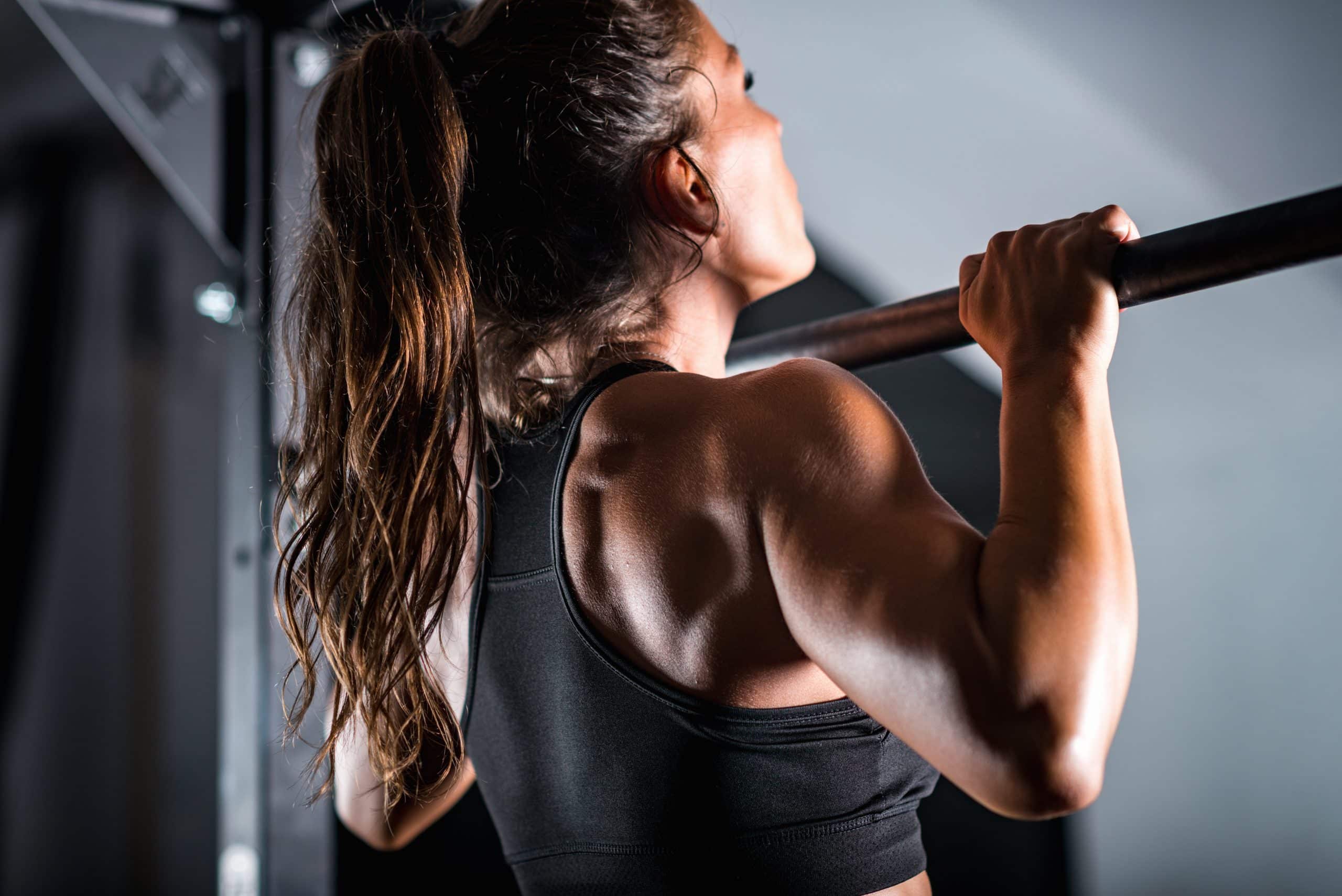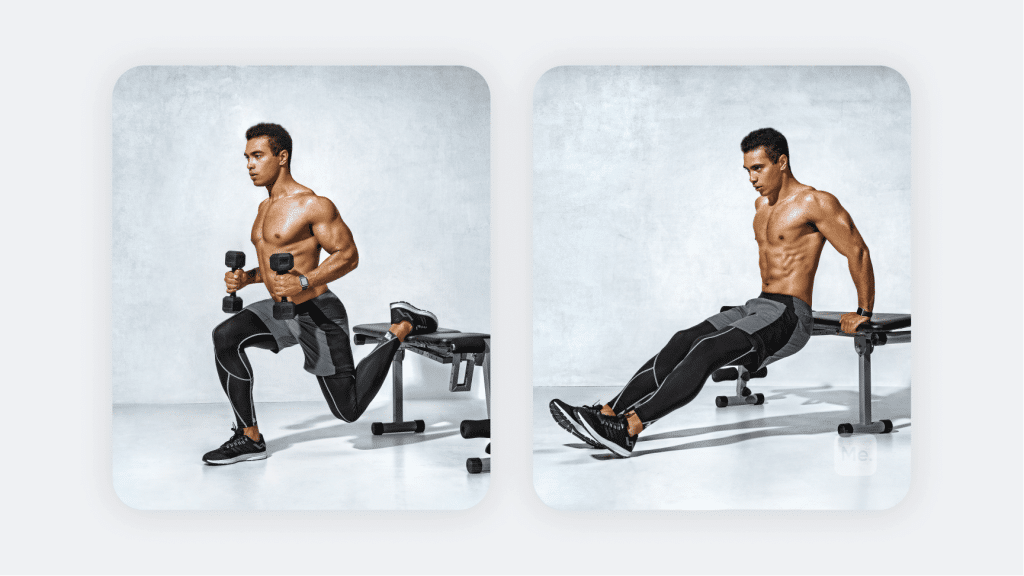Pulling is one of the seven primal movement patterns that are essential for overall health and fitness. Consequently, pull-ups and chin-ups are crucial components of functional fitness (the type of fitness that focuses on strength and movement for everyday activities). Both exercises are compound, multi-joint movements that require a lot of muscles to work in harmony. Let’s take a look at the differences between pull-ups and chin-ups, when to do them, and variations you can try. This information is useful if you want to progress with your strength training and helps prevent injury. As a result, you’ll be able to move better and feel more confident in your workouts.
Pull Up Vs. Chin Up: Differences
Below are the notable differences between pull-ups and chin-ups.
Grip Width
Grip width is the most apparent difference between the two exercises. Pull-ups involve a double overhand grip (palms facing away from you). This is also known as a pronated grip. Chin-ups involve a double underhand grip (palms facing you). This is also known as a supinated grip.
Your grip width is determined by the hand orientation we’ve described above. A pronated grip allows you to place your hands wider—at least shoulder-width apart. With time, you can increase the grip width to increase the intensity of the exercise.
A supinated grip, on the other hand, allows you to place your hands closer—somewhere between shoulder-width and a narrower grip.
Muscles Worked
The orientation of the hands and forearms will determine which muscles are targeted during each exercise.
Pull-ups involve a pronounced grip which targets the back muscles like the lats, teres major and minor, rhomboid, and the posterior deltoid. Chin-ups involve a supinated grip which works out the biceps, brachialis, lower and mid-trapezius, and the anterior deltoid.
Range Of Motion
The range of motion is also different in pull-ups and chin-ups.
Pull-ups involve a greater range of motion because the hands are placed wider apart. You can actually perform a full dead hang (where your arms are fully extended) in a pull up. In contrast, chin-ups involve a shorter range of motion because the hands are placed closer together.
Leg Position
The pull up requires you to keep your legs straight and together (without any movement). This is because the increased range of motion requires more stability from the core, hips, and legs. It also requires your body to be evenly distributed and balanced.
On the other hand, chin-ups require you to lift your chin up above the bar—a feat that can only be accomplished with a body hollow or arched position.
The body hollow refers to a tucked position—one in which the knees are bent and the legs are brought towards the chest. This increases momentum to lift your chin up above the bar.
Read More: Rack Pull Form: The Best Way To Perform This Deadlift Variation
Prerequisites
Both pull-ups and chin-ups require a sufficient level of upper body strength. Building up your grip, back and shoulder muscles can help prepare you for either pull-ups or chin-ups.
If you’re new to either exercise, start working on their foundational movements such as the bent-over row and renegade rows.
These will help you build the necessary strength to progress and perform either pull-ups or chin-ups.That said, each of these exercises involves different grip and hand placement, so you require specific strength for each one.
Pull ups require shoulder stability to move through the range of motion, as well as an even distribution of weight throughout the body. They also require more overall strength. As a result, they are a more difficult movement.
Chin-ups require more forearm and bicep strength to pull your chin up and over the bar.
Pull Up Vs. Chin Up: Similarities
Despite their differences, pull-ups and chin-ups do share similarities. Below are the main areas of similarity:
Core Engagement
Both pull-ups and chin-ups involve core engagement. This is because your core muscles help stabilize the body during each exercise. They also keep your spine aligned and engaged, while you’re in a dead hang position or during the motion of the exercise.
Loading
The loading or weight distribution is similar in pull-ups and chin-ups. In both exercises, your bodyweight is the main load you’re lifting, and it is distributed evenly across your entire body.
To increase the intensity of either exercise, you can add additional weight in the form of a weight plate, dipping belt, or dumbbell. The reverse is also true, you can reduce the load by taking away weight.
A resistance band can be used to reduce the load during either exercise. This is especially helpful for beginners who are still building up their strength for either pull-ups or chin-ups.
How To Do A Pull-Up
A pull-up is typically performed on a pull-up bar. You can also use a TRX or rings if you’re at a gym.
To do a pull-up:
- Start by gripping the bar with an overhand grip (palms facing away from you). Your hands should be slightly wider than shoulder-width apart.
- Then, pull your body up until you’re at eye level with the bar. Keep your core and glutes engaged throughout the movement. Your legs should remain straight and still.
- Pause at the top of the movement, then slowly lower your body back down to the starting position.
BetterMe app will provide you with a host of fat-frying fitness routines that’ll scare the extra pounds away and turn your body into a masterpiece! Get your life moving in the right direction with BetterMe!
When To Do A Pull Up
Pull-ups are a great exercise for building upper body strength and endurance (3). They are ideal for:
- Developing back, shoulder, and arm strength
- Building muscle mass
- Increasing grip strength and forearm endurance
- Developing shoulder mobility and stability
- As part of a strength and conditioning program
Pull ups are a great idea if you’re:
- An advanced lifter – pull-ups require absolute strength and shoulder stability which beginners may not have. Advanced lifters can benefit from the challenge and variation that pull-ups offer.
- Looking to build and improve shoulder function – the range of motion of a pull-up helps to improve shoulder mobility and stability.
- Looking for an exercise that will improve your ability to do the muscle up – the muscle up is an advanced variation of the pull-up and chin-up. Doing regular pull-ups will help you improve your strength for this exercise.
Pull Up Variations
To add variety to your pull-up training, you can incorporate different grip positions or move through different ranges of motion. Here are a few pull-up variations to try:
- Wide grip pull up – start with your hands wider than shoulder-width apart
- Narrow grip pull up – start with your hands closer together than a regular grip
- Chin up or reverse pull up – start with an underhand grip and pull yourself up until your chin is over the bar
- Weighted pull-up – add a weight plate or a back dip belt to add additional load
- Inverted pull-up – start in an inverted position with your hands gripping the bar, and pull yourself up until your chest is just above the bar
How To Do A Chin Up
A chin-up typically done using a chin-up bar, rings, or a TRX.
To do a chin-up:
- Start by gripping the bar with an underhand grip (palms facing you). Your hands should be slightly closer than shoulder-width apart.
- Then, pull your body up until your chin is above the bar. Keep your core and glutes engaged throughout the movement. Your legs should remain straight and still.
- Pause at the top of the movement, then slowly lower your body back down to the starting position.
When To Do A Chin Up
Chin-ups are a great exercise for building biceps and back strength. They also work your core and help improve grip strength (1).
Chin-ups can be used to:
- Develop biceps strength
- Build back and shoulder muscle mass
- Increase grip strength and forearm endurance
- Strengthen core muscles
- Prevent shoulder pain and injury
- As part of a strength and conditioning program
Chin ups are a good idea if you’re:
- A beginner – as a beginner, mastering the chin-up can be a great starting point for upper body exercises. It’s a good way to start building strength without having the absolute strength and shoulder stability of an advanced lifter.
- Looking to target your biceps – chin-ups work the biceps more than pull-ups, making it a great exercise for building bicep strength.
- Looking to build upper body muscle – performing many repetitions of an exercise is key for building muscle (2). Chin-ups allow you to do more repetitions with less weight than pull-ups, meaning it’s easier to hit the high-rep range needed to build muscle.
- Looking to build full body strength – chin-ups not only target the upper body, but also engage your core. This makes it a great exercise for building full body strength without overworking your back.
Read More: Rack Pull Benefits, Technique, And Muscles Worked
Chin Up Variations
Similar to pull-ups, you can add variety to your chin-up training by incorporating different grip positions or moving through different ranges of motion. Here are a few chin-up variations to try:
- Weighted chin up – add a weight plate or a back dip belt to add additional load
- Band assisted chin up – use a resistance band to reduce the load
- Single arm chin up – hold onto one side of the bar with only one hand
- Wide grip chin up – start with your hands wider than shoulder-width apart
- Narrow grip chin up – start with your hands closer together than a regular grip
- Inverted chin up – start in an inverted position with your hands gripping the bar, and pull yourself up until your chin is above the bar
Frequently Asked Questions
Below are answers to some of the frequently asked questions about pull-ups and chin-ups:
Are Chin Ups Better Than Pull Ups?
Chin-ups and pull-ups are both excellent upper body exercises, so it really depends on your goals.
Generally speaking, chin-ups are better for beginners whose shoulder stability is not yet developed enough for pull-ups. On the other hand, pull-ups are better for more advanced lifters who want to better target the back muscles.
Why Is Chin Up Harder Than Pull Up?
Chin-ups are typically harder than pull-ups because of the limited range of motion. With a chin-up, you are only able to lower your head just below the bar and then pull yourself back up.
On the other hand, with a pull-up you can lower your body all the way down to a full hang before pulling yourself back up.
Betterme will keep you laser-focused on your weight loss journey! Nutrient-packed meal plans, fat-blasting workouts, galvanizing challenges and much more. Try using the app and see for yourself!
Do Navy Seals Do Pull Ups Or Chin Ups?
Navy Seals do pull-ups as part of their training. Pull-ups are a great upper body exercise that build strength, endurance, and muscle mass in the back and arms. They also help improve grip strength, which is important for the Navy Seals.
Are Chin Ups Effective?
Yes, chin-ups are an effective exercise for building strength and muscle mass in the upper body. They are also helpful for improving grip strength, core stability, and shoulder health. In addition, chin-ups are a great exercise for beginners, due to the reduced range of motion. This can help build strength and stability before transitioning to pull-ups.
The Bottom Line
Pull ups and chin ups are two of the most effective upper body exercises for building strength, muscle mass, grip strength, and core stability. While they may look similar, they have different demands on your body.
DISCLAIMER:
This article is intended for general informational purposes only and does not serve to address individual circumstances. It is not a substitute for professional advice or help and should not be relied on for making any kind of decision-making. Any action taken as a direct or indirect result of the information in this article is entirely at your own risk and is your sole responsibility.
BetterMe, its content staff, and its medical advisors accept no responsibility for inaccuracies, errors, misstatements, inconsistencies, or omissions and specifically disclaim any liability, loss or risk, personal, professional or otherwise, which may be incurred as a consequence, directly or indirectly, of the use and/or application of any content.
You should always seek the advice of your physician or other qualified health provider with any questions you may have regarding a medical condition or your specific situation. Never disregard professional medical advice or delay seeking it because of BetterMe content. If you suspect or think you may have a medical emergency, call your doctor.
SOURCES:
- ACE Technique Series: Chin-ups (2016, acefitness.org)
- Maximizing Muscle Hypertrophy: A Systematic Review of Advanced Resistance Training Techniques and Methods (2019, nih.gov)
- The Surprising Benefits of Pull Ups You Should Know (2022, gympact.com)












